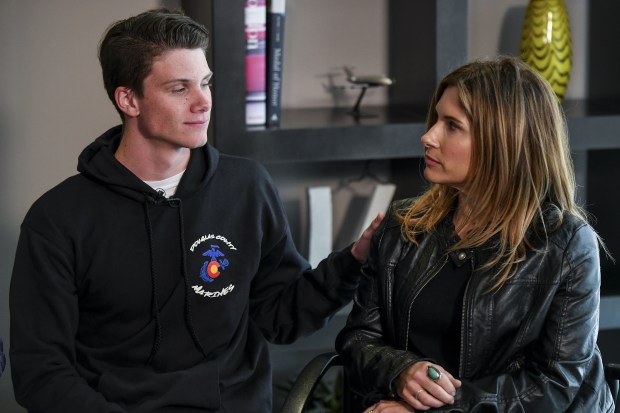
When two teenagers began firing on their classmates at STEM School Highlands Ranch last week, at least three students charged one of the suspects — a decision that cost one of the teens his life.
Kendrick Castillo’s death was the second within a week involving a student who tackled a perpetrator of a school shooting. Eight days earlier, Riley Howell was killed charging the gunman in a shooting at UNC Charlotte in North Carolina.
The actions by these students who took down shooters are heralded as heroic and credited for preventing further deaths. But their stories also have drawn concern from psychologists who worry that such narratives will place children and teens at further risk by sending the message they must act like a “superman or (super)woman” during mass shootings.
“We don’t want any kid, certainly some of the younger kids, thinking this is what they have to do,” said Dr. Steven Berkowitz, a visiting professor in psychiatry at the University of Colorado’s Anschutz Medical Campus.

Most school districts in the Denver metro area teach fighting back as an option during a shooting — but only when it’s not possible to get away from an attack.
At Jeffco Public Schools, where the massacre at Columbine High took place 20 years ago, students and teachers are encouraged to lock down their classrooms, if they can do so safely.
Encouraging people to stay in place cuts down on the chaos when law enforcement arrives and decreases the odds students will run into a shooter’s path or be injured accidentally if police fire on a suspect, said John McDonald, Jeffco’s executive director of school safety.
“People don’t understand that a lot of the lockdown tactics are to support our law enforcement officers,” he said.
However, fleeing the building is also an option, if students can get out the door faster than finding safe sheltering spots. Students defending themselves is another option, including in situations like at STEM School, when a perpetrator is already in a classroom. But schools don’t want students to seek out shooters, McDonald said.
At Denver Public Schools, the response options to a potential shooter are framed as “escape, evade, engage,” rather than “run, hide, fight.” This means getting out or hiding if students can, and engaging the shooter — including verbally — only if there is no better option, said Mike Eaton, chief of the safety department.
“I think ‘fight’ is sometimes misunderstood,” he said. “While we want to teach the kids to run away, it’s not always safe.”
Denver schools are in an urban area, so help from law enforcement will arrive within minutes, and students need to think in terms of how to survive those first minutes, Eaton said.
“There’s no cookie-cutter response to ‘If this, then that,’ ” he said.

The concerns about students putting themselves at risk by fighting back come as news coverage of mass shootings increasingly focuses more on the survivors and victims of such attacks than the perpetrators.
This is in response to the No Notoriety movement, which calls for press coverage to limit the focus on the identity of suspects to avoid giving them infamy and inspiring copycat attacks. (The Denver Post is using the names and photos of the STEM School shooting suspects sparingly.)
The No Notoriety group was started by Tom and Caren Teves after their son Alex was killed in the Aurora theater shooting in 2012.
During the attack, Alex shielded his girlfriend with his body, said Tom Teves.
“Did he do that because he wanted to be a hero or did he do that because he was heroic?” he said.
After the STEM School shooting last week, the National Association of School Psychologists issued a statement saying it was “encouraging” that some news organizations have focused their coverage on honoring the victims. But the association also expressed concern.
“We realize that there is a fine line between rightly recognizing the actions and celebrating the lives of the victims and unintentionally creating the perception that heroism in and of itself is a goal for our children in these situations,” the association said.

While it is understandable to not want to encourage kids to risk their lives, there is not enough data to support whether news coverage of students charging attackers is affecting others, said Jaclyn Schildkraut, associate professor in the criminal justice department at State University of New York at Oswego.
She added, “The reality is everybody that is commenting on this has never been in a shooting,” so none of us can say how we would react.
But Berkowitz said stories of heroism can put additional pressure on children and teenagers in what is already a stressful situation, including making youths feel like they are responsible and need to act “heroically” — and making students who didn’t fight back feel guilty.
“The harm is that they act in a heroic manner and put themselves in danger,” he said. “That’s not their job. They’re not in the military. They’re young people and they have lives ahead of them.”




![By JONEL ALECCIA (AP Health Writer) The nation’s school meals will get a makeover under new nutrition standards that limit added sugars for the first time, the U.S. Department of Agriculture announced Wednesday. The final rule also trims sodium in kids’ meals, although not by the 30% first proposed in 2023. And it continues to […] By JONEL ALECCIA (AP Health Writer) The nation’s school meals will get a makeover under new nutrition standards that limit added sugars for the first time, the U.S. Department of Agriculture announced Wednesday. The final rule also trims sodium in kids’ meals, although not by the 30% first proposed in 2023. And it continues to […]](https://www.denverpost.com/wp-content/uploads/2024/04/School_Meals_Standards_90008.jpg?w=525)